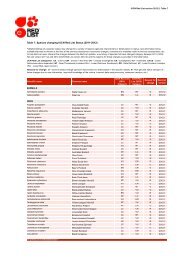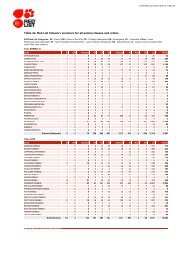IUCN Red List Guidelines - The IUCN Red List of Threatened Species
IUCN Red List Guidelines - The IUCN Red List of Threatened Species
IUCN Red List Guidelines - The IUCN Red List of Threatened Species
You also want an ePaper? Increase the reach of your titles
YUMPU automatically turns print PDFs into web optimized ePapers that Google loves.
<strong>Red</strong> <strong>List</strong> <strong>Guidelines</strong> 46<br />
VU) apply, which may lead to a down-listing <strong>of</strong> the taxon that would reflect the fact that it is<br />
currently stable or increasing, (2) uncertainty in the data (particularly long-term historical<br />
data) if properly incorporated into the assessment may affect the outcome <strong>of</strong> the listing (see<br />
section 3.2).<br />
5.4 Severely depleted populations<br />
Some taxa (particularly marine taxa) show persistence at very low fractions <strong>of</strong> their<br />
unexploited equilibrium or carrying capacity. <strong>The</strong>se taxa may not qualify under criterion A1<br />
or A2 because their declines occurred more than three generations ago, and they may be too<br />
widespread and abundant to qualify under any other criteria. Nevertheless, they may be more<br />
cause for concern because they are more susceptible to unforeseen catastrophic events and<br />
marine taxa may be harvested as bycatch in other fisheries. Such taxa are not currently being<br />
assessed as threatened under the criteria A1 and A2, although they may still qualify under<br />
criteria A3, A4, B, C, D or E.<br />
Taxa in this situation may be assessed under criteria A3 or A4 based on projected or<br />
suspected population declines in the future, provided there is sufficient evidence for the<br />
threats faced by the taxon or the likely decline rate <strong>of</strong> the taxon to warrant such a listing. <strong>The</strong><br />
category Near <strong>Threatened</strong> could also be used if a taxon nearly qualifies as Vulnerable under<br />
A3 or A4. It must be remembered however that the <strong>IUCN</strong> <strong>Red</strong> <strong>List</strong> Criteria are designed to<br />
identify taxa that exhibit symptoms <strong>of</strong> endangerment, and not simply depletion or<br />
conservation priority. <strong>The</strong> problem <strong>of</strong> assessing these taxa is also related to the scaling<br />
issues discussed under the definition <strong>of</strong> area <strong>of</strong> occupancy (section 4.10), which affects the<br />
application <strong>of</strong> criterion B. If an appropriate taxon-specific scaling factor is used, severely<br />
depleted marine taxa may qualify as threatened under criterion B.<br />
5.5 Fisheries<br />
Taxa that are the target <strong>of</strong> fisheries may show a decline in population size due to intentional<br />
management action. Under the <strong>Red</strong> <strong>List</strong> Criteria, such taxa could be assigned a threatened<br />
status under criterion A (declining population). Concern has been expressed that such a<br />
listing might not reflect extinction risk, especially if the decline is a consequence <strong>of</strong> a<br />
management plan designed to achieve a goal such as the maximisation <strong>of</strong> sustainable yield<br />
from a fishery. Such listings should not be problematic in the medium- to long-term<br />
because, if the fishery is managed effectively, although it currently exhibits symptoms<br />
consistent with endangerment, the population will eventually stabilize at a target level and<br />
the decline will end, such that the taxon would then no longer qualify for listing. If declines<br />
continued, there would be reason for concern; in this case a new assessment, against all five<br />
criteria, may indicate that the taxon is still threatened. In addition, fisheries that are being<br />
managed sustainably should be assessed under criterion A1, where the higher thresholds <strong>of</strong><br />
90% (CR), 70% (EN) and 50% (VU) make it less likely that they will be classified as<br />
threatened.<br />
5.6 Trees<br />
<strong>The</strong> generation length <strong>of</strong> some tree species can exceed 100 years. It is difficult to estimate<br />
population declines from a point in time before which the species populations or even the






